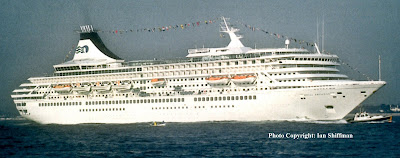Why was ORIANA required?
In 1988 a meeting of the directors of P&O Cruises was held to discuss the direction of the company over the next 5 year period. At this time it had been predicted by cruise industry experts that the number of cruise passengers was to rapidly increase.
This increase which had already been felt by the company’s American based subsidiary Princess Cruise. The North American market was mainly focused in the Caribbean and also saw many British passengers head across the Atlantic to join the ships on so called fly cruises. At the same time a increase of passenger bookings was seen in the UK based operations sole ship the veteran liner Canberra.
From the view point of the public Canberra had become something of a British institution since the ships role in the Falklands War. The valiant ship was rated as one of the most popular ships to cruise on and accounted for 45% of all cruises that departed from or arrived in a UK port.

 Canberra in Funchal, Madeira 18 October 1980.
Canberra in Funchal, Madeira 18 October 1980. However the reality that faced P&O was somewhat different, despite the popularity of the ship after 27 years in service she was beginning to suffer age related technical problems with the turbo-electric propulsion machinery and with high maintenance costs was becoming increasingly expensive to keep in cruise service.
When compared to the last new build P&O had undertaken Royal Princess 4 years earlier the differences and advantages of a modern ship with more advanced technology could be clearly seen. Of a similar tonnage to Canberra at 22 knots the ship consumed 70 tons of fuel per day compared to Canberra’s 250 tons per day at 20 knots.
 Princess’s Royal Princess
Princess’s Royal PrincessWith these facts the decision was taken to transfer Sea Princess (former Kungsholm for Swedish America Line) back to the UK market to handle the increase in passenger numbers on a short term basis.
 Sea Princess in Princess livery
Sea Princess in Princess liveryFor the longer term it was decided to begin a study into the possibility to built a new ship to serve exclusively for the British market.
“Gemini”
Given the name Project Gemini the study took to account in all aspects associated with building a new ship concluded in 1989 and its finding were that by the early 1990s P&O’s passenger numbers would have risen to such a level that building a newer larger ship would be a option if certain conditions were met these included:
-The ship would need to be of at least 50,000 tons.
-For the cruising role envisioned for the new ship it would need to have a higher speed than is usually associated with cruise ships.
With the information it needed P&O turned to its subsidiary company Three Quays Maritime Services to start drawing up general arrangement drawings for the new ship and inviting shipyards to tender for the new liners construction.
Although it may seem premature for a company to be looking to shipyards before even the most basic design work had been completed but as P&O’s marketing director David Dingle said at the time “ Any large and successful cruise line should always have plans available, opportunities to order very greatly, according to exchange rates, shipyard availability and financial packages available . Companies must have plans ready to take advantage at any time”
By the end of 1989 letters had been sent out to 12 shipyards across Europe including three British ones which P&O ideally would want to build the ship.
Due to the decline of British Shipbuilding none of the yards were able to accept, of those that did respond three proposals seemed promising one a unnamed yard in Finland and the others both in Germany they were Lloyd Werft of Bremerhaven and Meyer Werft of Papenburg.
 So with over 150 years of experience behind them P&O embarked on their latest challenge to build its largest and most luxurious ship, a ship to proudly take P&O and British cruising into the 21st century.
So with over 150 years of experience behind them P&O embarked on their latest challenge to build its largest and most luxurious ship, a ship to proudly take P&O and British cruising into the 21st century.Development: © Steve Martin.
Don't miss next week the second post of Part 1-Art and Conception, Early Designs and Concept.

Sem comentários:
Enviar um comentário